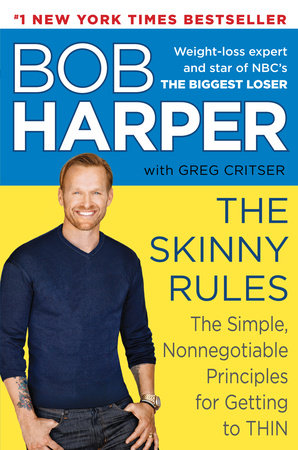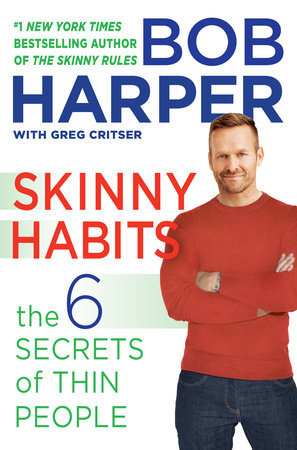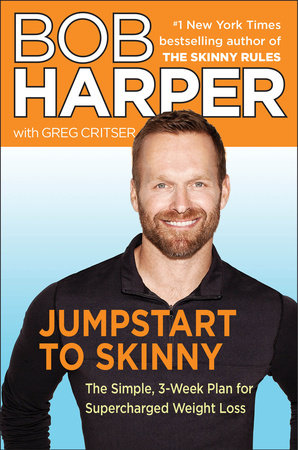Excerpt
The Skinny Rules
RULE 1
DRINK A LARGE GLASS OF WATER BEFORE EVERY MEAL—NO EXCUSES!
This has got to be the easiest rule there is. Which is a good place to start. But it’s also one of the most important rules there is. You simply must stay hydrated. At a minimum I want you to drink a large glass of water before every meal. But I’d prefer that you drink at least five glasses of water a day, the first one within fifteen minutes of waking.
Now, do I really need to harass you about this? I do. Because during the process of losing weight, nothing is so crucial to your success. Water keeps your organs healthy while you’re sweating, keeps food moving through the system, and makes you feel full.
Let me put this plainly: drinking water helps you lose weight. You can see this most vividly in very overweight children. Recently, a group of Israeli researchers examined the resting energy expenditure (REE) of twenty-one obese children. REE refers to the rate at which you burn calories when you are sleeping, watching TV, or just simply sitting there and staring into space. The researchers gave the kids a large serving of cold water, then began measuring the REE every 10 minutes. The reaction was more robust than anticipated. Within 24 minutes, REE began increasing. By 57 minutes, REE had increased by 25 percent, and this effect lasted 40 minutes.
Did you get that? Just by drinking water, your body increases its burning of calories. The scientists estimated that, if you just do this, you’ll burn off an extra three pounds over the next year.
That doesn’t sound like a lot, but I’ll take it. Won’t you?
The contestants on The Biggest Loser are usually chronically dehydrated, and their collective experience shows another reason to drink lots of water. They are usually pretty big consumers of salt before they come on the show. They eat it unknowingly—in the fried and highly processed foods that are their usual mealtime fare and that helped make them so overweight in the first place—and knowingly; too many of them often add salt to whatever they are served. They are usually eating so much salt that they have begun to mess up the delicate mechanisms of chemical balance so vital to our bodies. When the kidneys are swamped with salt and without adequate liquids, you don’t get enough potassium. That and other minerals are absolutely key to weight loss.
And as my private fitness clients have shown me, drinking more water helps in other physical ways as well. When they start conscientiously drinking lots of water, their workouts improve. They get less muscle fatigue, they recuperate faster, and they don’t feel groggy in the afternoon.
Simple Hydration Tips
Make it your premeal policy: drink a large glass of water before every meal. No excuses.
End the day with preparation for a good start to the next: put a large, full glass of water on your bedstand every night and drink it when you wake up, every morning.
Get a little extra bang for your effort: mix a pitcher of water with a noncaloric vitamin and mineral supplement. I like ElectroMix (one little packet makes a quart), and having the pitcher all mixed and right in front of you will make it that much easier to pour yourself a glass when you open the fridge at every meal; I usually drink mine when I work out.
RULE 2
DON’T DRINK YOUR CALORIES
Caloric beverages steal your health and they steal great food from you. That’s right. They steal it because they are so heavily caloric themselves and will fill you up with all the wrong stuff. Think of the kinds of caloric beverages all around you.
Soft drinks: As you heft one of those cans or buckets of sugar water to your mouth, consider that you are actually eating the equivalent of what should be your entire lunch.
I came to this rule while working on TBL. When I reviewed their pre-TBL meal plans I saw that most contestants were drinking Big Gulps or other massive jugs of soda that had 500 calories. Some people would nurse several of them during the day (that’s upwards of 1,500 calories of soda a day!). Think of it this way: all that corn syrup? It’s a bushel of corn! And remember, when factory farms want to fatten their cattle, what do they do? They feed them corn. So if you are drinking things with corn syrup, think about that. Are you a cow? No you are not.
Moreover, when you drink soda, you are ingesting what just about every legitimate medical authority in the world has named as suspect number one in today’s sprawling diabetes epidemic. A friend of mine tells me that his teenage kids really got the message a few years ago when their father was diagnosed. Now, when a family member asks for a soda, they cheerily reply: “Sure. What kind of diabetes do you want?”
Out of the mouths of babes.
If, like most Americans, you are used to drinking lots of liquid calories, cutting out soda might be a tough adjustment. But it’s essential that you kick your soda habit ASAP. If you’re a full-calorie soda drinker, you’re guzzling empty and unsatisfying calories. If you’re a diet/zero-calorie soda drinker, you haven’t dodged the problem. Hello?! You’re guzzling artificial sweeteners and, as you’ll hear again and again in this book, I don’t think highly of these at all. They only serve to whet your appetite for more sweet! Stop the madness. Kick the habit.
To help wean yourself from your soda habit, start experimenting with other flavored, noncaloric drinks that you can make yourself. Try seltzer water with lime or lemon juice. Stock up on unsweetened, naturally flavored herb teas. Make a quart or so at a time and keep it in the refrigerator to go with your afternoon snack. And there is my tried-and-true alternative—the “soda eliminator” described in Rule 15. Check it out.
Juices and juice drinks: Most juices have exactly the same number of calories—and the same amount of simple sugars—as a cola. Oh, you’ll protest, but doesn’t the fiber in a “natural” juice obviate that problem? No. That’s just what you’ve been told. It is the same as drinking a soft drink. You want fruit? Eat fruit. The whole piece of fruit. Not the extracted and manipulated juice.
Yeah, well, juice smoothies are healthy, right? Maybe “healthy” if you order one with no preservatives or added sugar, but regardless, fruit smoothies that you haven’t made yourself (i.e., you have controlled the portions and know exactly what’s gone in it) will make you as fat as a Macy’s Thanksgiving Day Parade float—just like a 32-ounce soda.
Energy replacement drinks: Well, yeah—if you’re training for a marathon. Otherwise, look at the label! A 20-ounce sports drink—let’s face it, that’s how much you’ll “need” to quench that big thirst—weighs in at 130 calories. Like a 12-ounce cola, but without the nifty zing of bubbles and caffeine. I’ve always seen drinks like these as particularly insidious, because they are, in our heads at least, deeply associated with sports, which are deeply associated with health and fitness. You have to break that connection.
Artificial Sweeteners
Though the scientific jury is still out on whether there is a direct relationship between consuming artificial sweeteners and the urge to eat more sweet-tasting things, I know this from experience with clients, with The Biggest Loser contestants, and with myself: the more “sweet” you eat, the more you want it. Another way to put it: when you taste sweet (even the tiny-calorie, artificial kind), you are conditioning yourself to continue wanting and even craving that same sweetness. That continued craving isn’t going to help you lose weight—ever. The biggest favor you can do yourself is to leave your sweet consumption to your splurge meal and learn to keep sweet indulgences in perspective: they are treats, not everyday affairs.
A latte on the way to the gym? Sorry. Milk also has a tanker-full of calories. True, coffee itself—which most of the world drinks without milk, by the way—is turning out to be a positive dietary element, although it’s still unclear why and how much. I’ll get back to that later, but for now, no lattes or chais, frappes, or mochas. If you must get something Euro, get a cappuccino, which contains very little milk (if made the right way), or even an Americano, in which you can better control the amount of milk. And if you must add milk, opt for the low- or no-fat varieties. No cream. No half and half. Whole milk? No again.
Alcohol: Although it might sound odd, if there’s one source of liquid calories that warrants some leeway in my no-sweetened-beverage world, it’s booze. Wine, particularly red wine, deserves a place on your shelf—and on your table. But not when you are trying to lose weight! Until you are at your goal weight, it’s best to view alcohol the same way you would a Big Gulp. When you get to your goal, red wine is the thing. When you’ve kept to your goal, we’ll talk beer.
In the same way I want you to step down from soda, I want you to immediately lay off the cream or half-and-half in your coffee. Don’t even go for the whole milk. Step down, step away! Start putting 2% milk or nonfat (skim) milk in your coffee and ordering any coffee-based drink that way too. Today.
Now, why am I so down on liquid calories? Most of us know the basics: sugary drinks contain, uh, sugar, and sugar is made up of molecules that encourage the formation of new fat cells, as well as keeping existing ones filled. This applies to all sugars, from “natural” ones like honey and juices, to the twin demon spawn of white sugar and high fructose corn syrup. Sugars drive up your blood sugar, which tells the pancreas to make more insulin, which makes you hungry, setting the whole process in motion again.
But what if I told you this: humans are simply not built to consume liquid calories.
Period.
That’s the growing consensus among nutritionists and medical researchers. In “A Short History of Beverages and How Our Body Treats Them,” obesity experts led by the preeminent Barry Popkin scrutinized our evolutionary history and tried to explain why our modern bodies handle them so poorly. Why, for example, do liquid calories make it difficult for our bodies to gauge when they are satisfied, or when to stop eating? After looking at the bodily effects of everything from beer to pop, they put forward a stunning conclusion:
“First,” they write, “humans may lack a physiological basis for processing carbohydrate or alcoholic calories in beverages because only breast milk and water were available for the vast majority of our evolutionary history. Alternatives to those two beverages appeared in the human diet no more than 11,000 years ago, but Homo sapiens evolved between 100,000 and 200,000 years ago. Second, carbohydrate and alcohol-containing beverages may produce an incomplete satiation sequence which prevents us from becoming satiated on these beverages.”
Translation: when you drink lots of liquid calories, you’re fighting 200,000 years of human history!
You’re not going to win.
WHY I DRINK COFFEE
Mainly, because I like it! That rich, complex bundle of flavors and smells is comforting and arousing. It makes me happy. But the latest research shows that coffee—in moderation—seems to have all kinds of other benefits as well. Consuming a couple cups (black) a day is strongly tied to lower rates of diabetes, more robust anti-inflammatory gene expression, and better and clearer thinking. It’s unclear why coffee does this, but one obvious suspect is caffeine. It is a stimulant, and stimulants generally dampen appetite and increase calorie burning. But . . . I drink it because I like it. As the smell of it wafts into my nostrils, I can close my eyes and envision being in Paris, which is a terrific image. Outside of France, here are some guidelines:
Drink espresso or black Americano only. Just do it! If you want a cappuccino, opt for nonfat or soy milk in the preparation. That’s how I enjoy mine.
Limit consumption to two cups a day, preferably before noon. Exception: you can drink it all day if you are indeed in Paris.
Decaf espresso is fine after lunch until around five. After that even the small amounts of caffeine will disturb your sleep.







